Analysis of Unilever's Marketing Process, Planning, and Marketing Mix
VerifiedAdded on 2023/06/05
|20
|5292
|100
Report
AI Summary
This report provides an in-depth analysis of Unilever's marketing strategies, encompassing marketing concepts, functions, and the extended marketing mix. It explores the role of the marketing function within the organization, its interaction with other departments, and how the marketing mix contributes to Unilever's overall business objectives. The report evaluates Unilever's application of the 7Ps of marketing (Product, Price, Place, Promotion, People, Process, and Physical Evidence) and offers recommendations for maximizing profit and achieving a competitive edge. It also highlights the interpersonal relationship between marketing and other departments, emphasizing how this collaboration leads to better organizational performance. The document concludes that effective marketing is crucial for presenting a product in the market and achieving organizational success. Desklib provides students access to similar solved assignments.
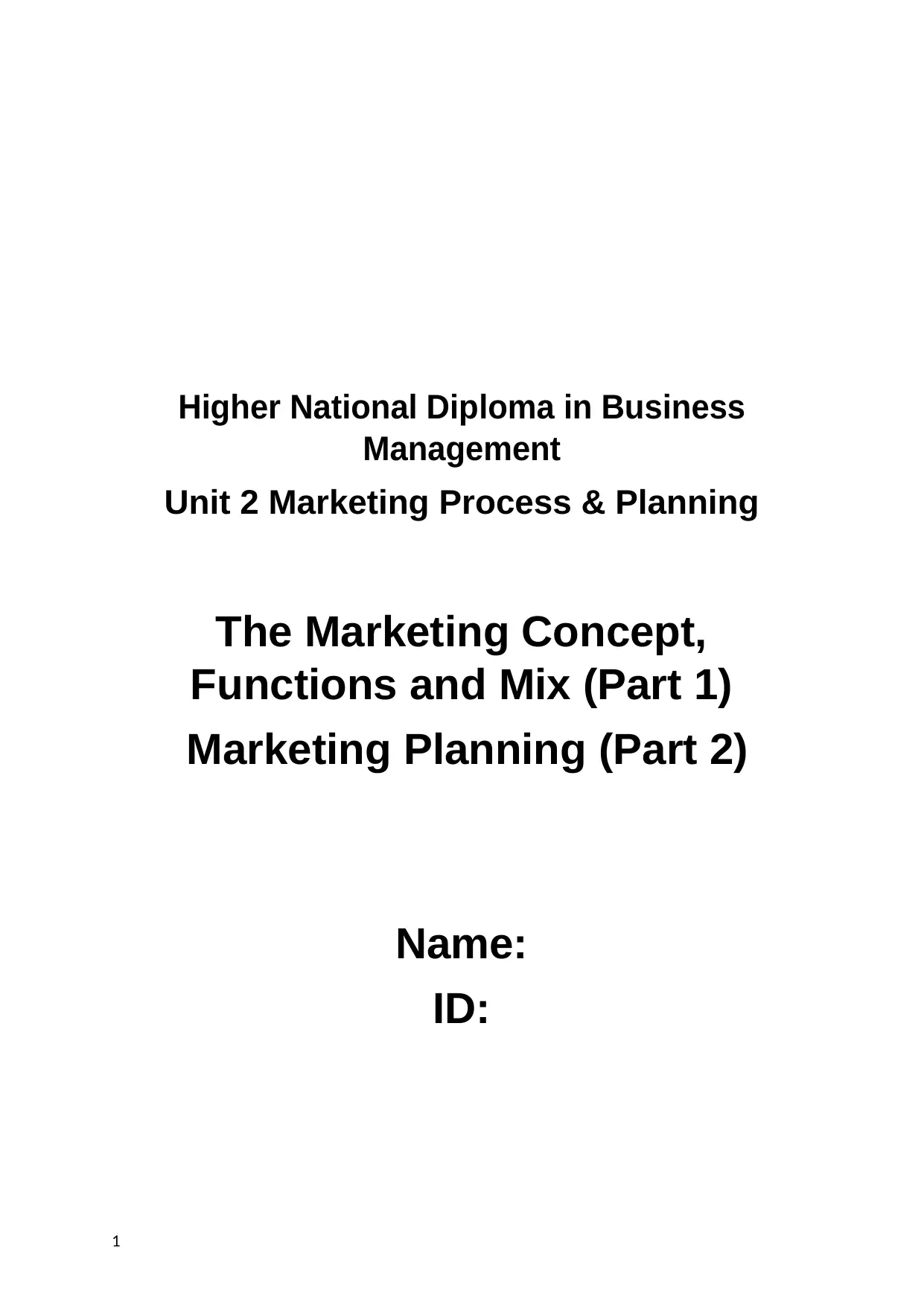
Higher National Diploma in Business
Management
Unit 2 Marketing Process & Planning
The Marketing Concept,
Functions and Mix (Part 1)
Marketing Planning (Part 2)
Name:
ID:
1
Management
Unit 2 Marketing Process & Planning
The Marketing Concept,
Functions and Mix (Part 1)
Marketing Planning (Part 2)
Name:
ID:
1
Paraphrase This Document
Need a fresh take? Get an instant paraphrase of this document with our AI Paraphraser
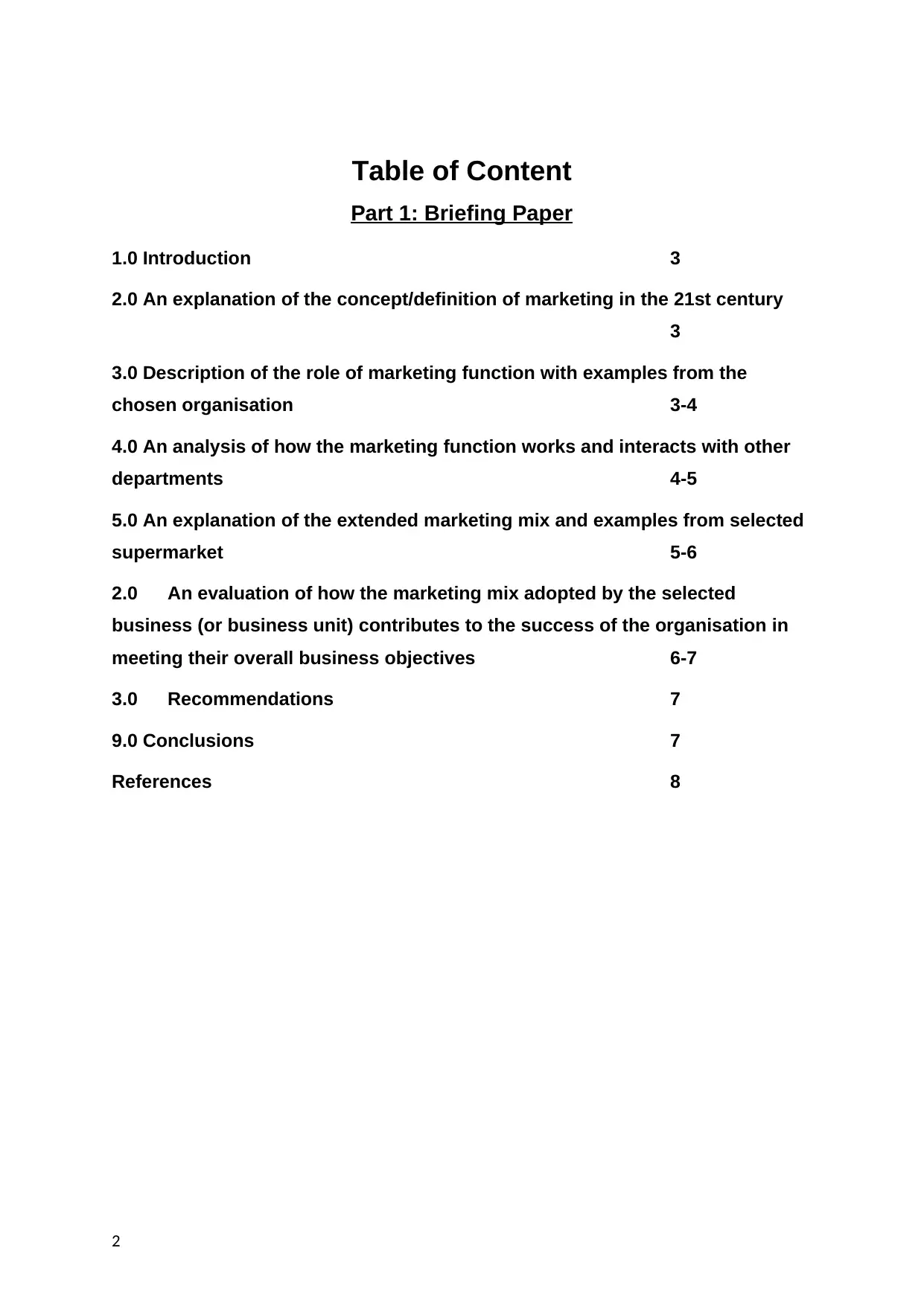
Table of Content
Part 1: Briefing Paper
1.0 Introduction 3
2.0 An explanation of the concept/definition of marketing in the 21st century
3
3.0 Description of the role of marketing function with examples from the
chosen organisation 3-4
4.0 An analysis of how the marketing function works and interacts with other
departments 4-5
5.0 An explanation of the extended marketing mix and examples from selected
supermarket 5-6
2.0 An evaluation of how the marketing mix adopted by the selected
business (or business unit) contributes to the success of the organisation in
meeting their overall business objectives 6-7
3.0 Recommendations 7
9.0 Conclusions 7
References 8
2
Part 1: Briefing Paper
1.0 Introduction 3
2.0 An explanation of the concept/definition of marketing in the 21st century
3
3.0 Description of the role of marketing function with examples from the
chosen organisation 3-4
4.0 An analysis of how the marketing function works and interacts with other
departments 4-5
5.0 An explanation of the extended marketing mix and examples from selected
supermarket 5-6
2.0 An evaluation of how the marketing mix adopted by the selected
business (or business unit) contributes to the success of the organisation in
meeting their overall business objectives 6-7
3.0 Recommendations 7
9.0 Conclusions 7
References 8
2
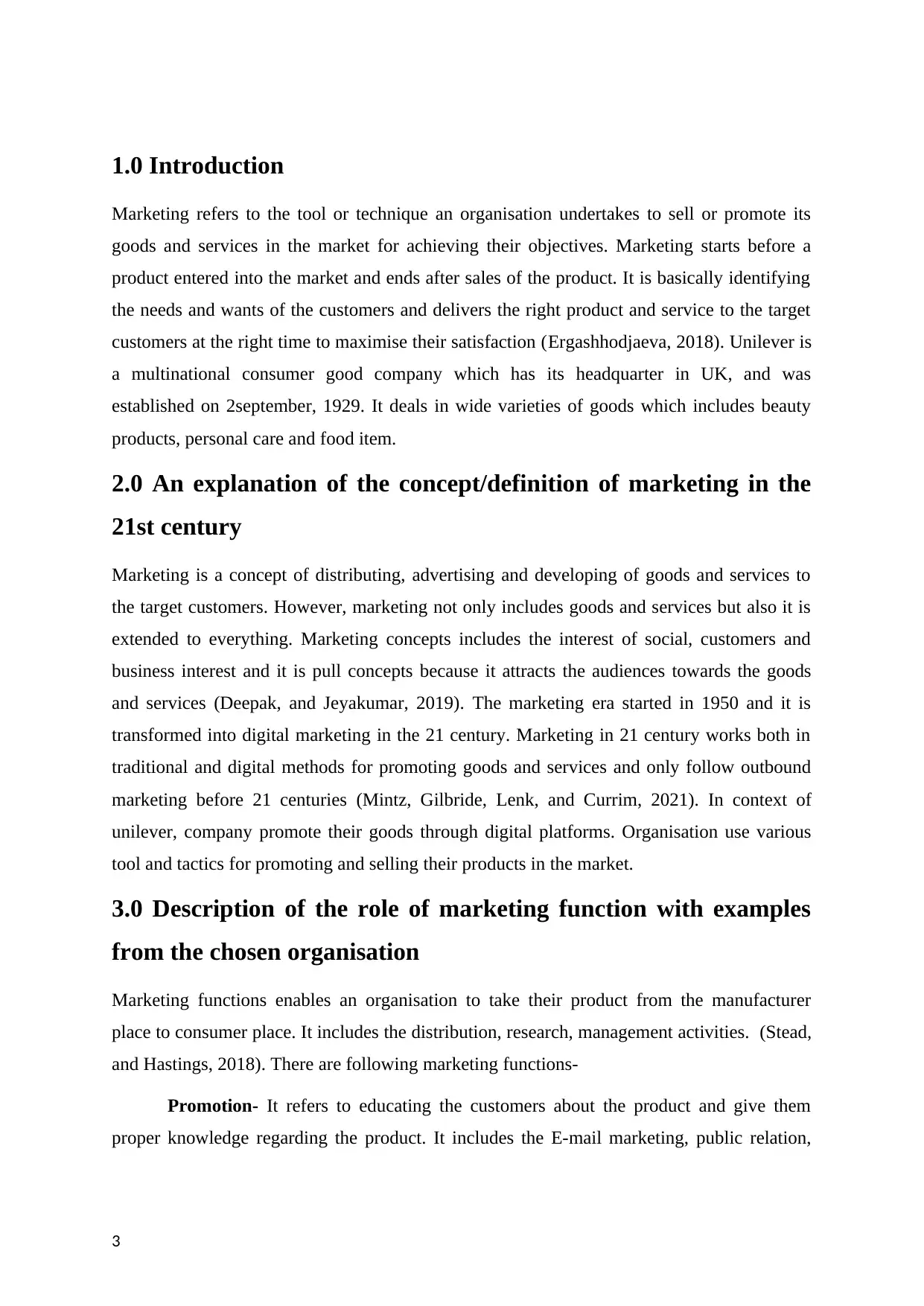
1.0 Introduction
Marketing refers to the tool or technique an organisation undertakes to sell or promote its
goods and services in the market for achieving their objectives. Marketing starts before a
product entered into the market and ends after sales of the product. It is basically identifying
the needs and wants of the customers and delivers the right product and service to the target
customers at the right time to maximise their satisfaction (Ergashhodjaeva, 2018). Unilever is
a multinational consumer good company which has its headquarter in UK, and was
established on 2september, 1929. It deals in wide varieties of goods which includes beauty
products, personal care and food item.
2.0 An explanation of the concept/definition of marketing in the
21st century
Marketing is a concept of distributing, advertising and developing of goods and services to
the target customers. However, marketing not only includes goods and services but also it is
extended to everything. Marketing concepts includes the interest of social, customers and
business interest and it is pull concepts because it attracts the audiences towards the goods
and services (Deepak, and Jeyakumar, 2019). The marketing era started in 1950 and it is
transformed into digital marketing in the 21 century. Marketing in 21 century works both in
traditional and digital methods for promoting goods and services and only follow outbound
marketing before 21 centuries (Mintz, Gilbride, Lenk, and Currim, 2021). In context of
unilever, company promote their goods through digital platforms. Organisation use various
tool and tactics for promoting and selling their products in the market.
3.0 Description of the role of marketing function with examples
from the chosen organisation
Marketing functions enables an organisation to take their product from the manufacturer
place to consumer place. It includes the distribution, research, management activities. (Stead,
and Hastings, 2018). There are following marketing functions-
Promotion- It refers to educating the customers about the product and give them
proper knowledge regarding the product. It includes the E-mail marketing, public relation,
3
Marketing refers to the tool or technique an organisation undertakes to sell or promote its
goods and services in the market for achieving their objectives. Marketing starts before a
product entered into the market and ends after sales of the product. It is basically identifying
the needs and wants of the customers and delivers the right product and service to the target
customers at the right time to maximise their satisfaction (Ergashhodjaeva, 2018). Unilever is
a multinational consumer good company which has its headquarter in UK, and was
established on 2september, 1929. It deals in wide varieties of goods which includes beauty
products, personal care and food item.
2.0 An explanation of the concept/definition of marketing in the
21st century
Marketing is a concept of distributing, advertising and developing of goods and services to
the target customers. However, marketing not only includes goods and services but also it is
extended to everything. Marketing concepts includes the interest of social, customers and
business interest and it is pull concepts because it attracts the audiences towards the goods
and services (Deepak, and Jeyakumar, 2019). The marketing era started in 1950 and it is
transformed into digital marketing in the 21 century. Marketing in 21 century works both in
traditional and digital methods for promoting goods and services and only follow outbound
marketing before 21 centuries (Mintz, Gilbride, Lenk, and Currim, 2021). In context of
unilever, company promote their goods through digital platforms. Organisation use various
tool and tactics for promoting and selling their products in the market.
3.0 Description of the role of marketing function with examples
from the chosen organisation
Marketing functions enables an organisation to take their product from the manufacturer
place to consumer place. It includes the distribution, research, management activities. (Stead,
and Hastings, 2018). There are following marketing functions-
Promotion- It refers to educating the customers about the product and give them
proper knowledge regarding the product. It includes the E-mail marketing, public relation,
3
⊘ This is a preview!⊘
Do you want full access?
Subscribe today to unlock all pages.

Trusted by 1+ million students worldwide
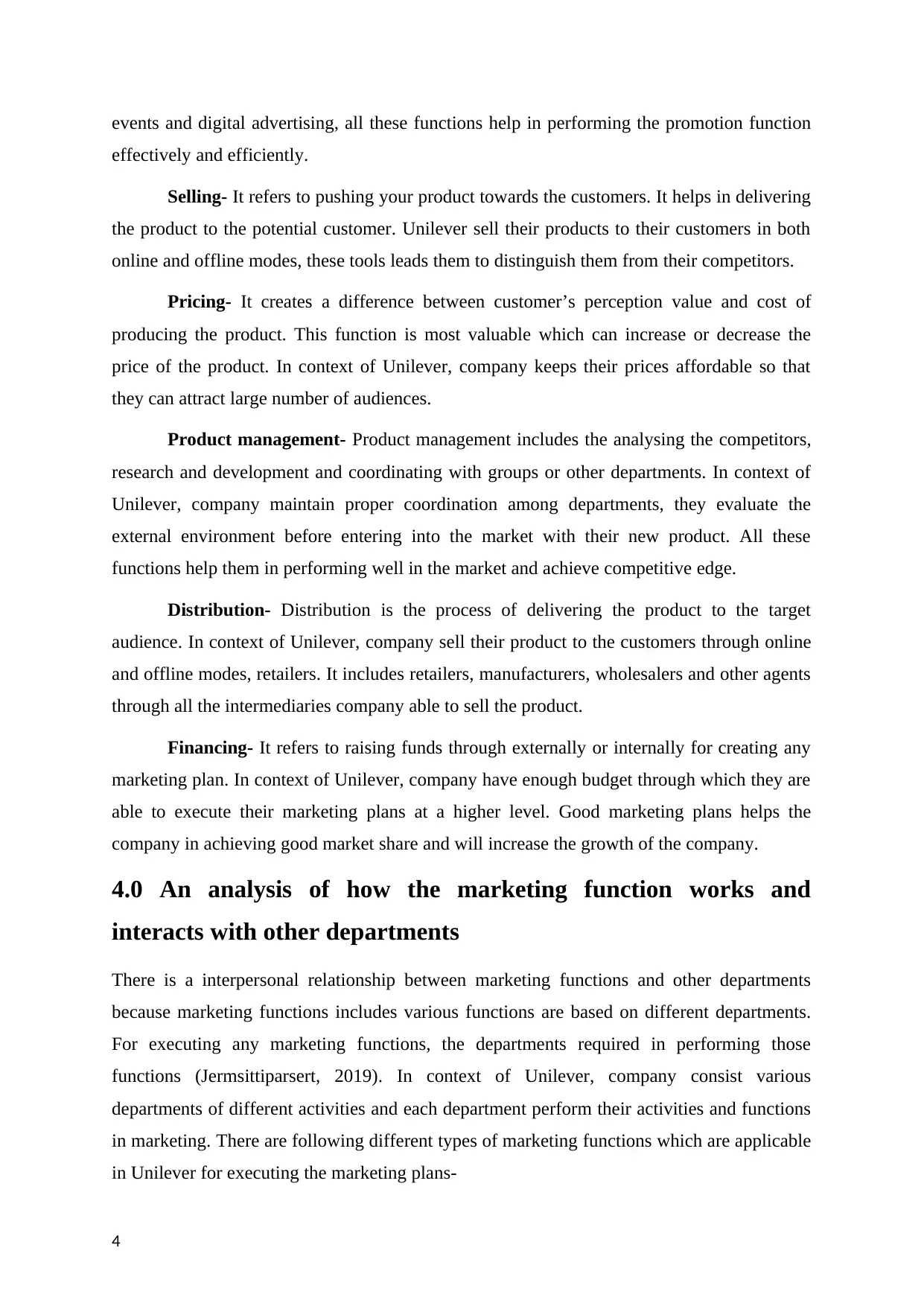
events and digital advertising, all these functions help in performing the promotion function
effectively and efficiently.
Selling- It refers to pushing your product towards the customers. It helps in delivering
the product to the potential customer. Unilever sell their products to their customers in both
online and offline modes, these tools leads them to distinguish them from their competitors.
Pricing- It creates a difference between customer’s perception value and cost of
producing the product. This function is most valuable which can increase or decrease the
price of the product. In context of Unilever, company keeps their prices affordable so that
they can attract large number of audiences.
Product management- Product management includes the analysing the competitors,
research and development and coordinating with groups or other departments. In context of
Unilever, company maintain proper coordination among departments, they evaluate the
external environment before entering into the market with their new product. All these
functions help them in performing well in the market and achieve competitive edge.
Distribution- Distribution is the process of delivering the product to the target
audience. In context of Unilever, company sell their product to the customers through online
and offline modes, retailers. It includes retailers, manufacturers, wholesalers and other agents
through all the intermediaries company able to sell the product.
Financing- It refers to raising funds through externally or internally for creating any
marketing plan. In context of Unilever, company have enough budget through which they are
able to execute their marketing plans at a higher level. Good marketing plans helps the
company in achieving good market share and will increase the growth of the company.
4.0 An analysis of how the marketing function works and
interacts with other departments
There is a interpersonal relationship between marketing functions and other departments
because marketing functions includes various functions are based on different departments.
For executing any marketing functions, the departments required in performing those
functions (Jermsittiparsert, 2019). In context of Unilever, company consist various
departments of different activities and each department perform their activities and functions
in marketing. There are following different types of marketing functions which are applicable
in Unilever for executing the marketing plans-
4
effectively and efficiently.
Selling- It refers to pushing your product towards the customers. It helps in delivering
the product to the potential customer. Unilever sell their products to their customers in both
online and offline modes, these tools leads them to distinguish them from their competitors.
Pricing- It creates a difference between customer’s perception value and cost of
producing the product. This function is most valuable which can increase or decrease the
price of the product. In context of Unilever, company keeps their prices affordable so that
they can attract large number of audiences.
Product management- Product management includes the analysing the competitors,
research and development and coordinating with groups or other departments. In context of
Unilever, company maintain proper coordination among departments, they evaluate the
external environment before entering into the market with their new product. All these
functions help them in performing well in the market and achieve competitive edge.
Distribution- Distribution is the process of delivering the product to the target
audience. In context of Unilever, company sell their product to the customers through online
and offline modes, retailers. It includes retailers, manufacturers, wholesalers and other agents
through all the intermediaries company able to sell the product.
Financing- It refers to raising funds through externally or internally for creating any
marketing plan. In context of Unilever, company have enough budget through which they are
able to execute their marketing plans at a higher level. Good marketing plans helps the
company in achieving good market share and will increase the growth of the company.
4.0 An analysis of how the marketing function works and
interacts with other departments
There is a interpersonal relationship between marketing functions and other departments
because marketing functions includes various functions are based on different departments.
For executing any marketing functions, the departments required in performing those
functions (Jermsittiparsert, 2019). In context of Unilever, company consist various
departments of different activities and each department perform their activities and functions
in marketing. There are following different types of marketing functions which are applicable
in Unilever for executing the marketing plans-
4
Paraphrase This Document
Need a fresh take? Get an instant paraphrase of this document with our AI Paraphraser
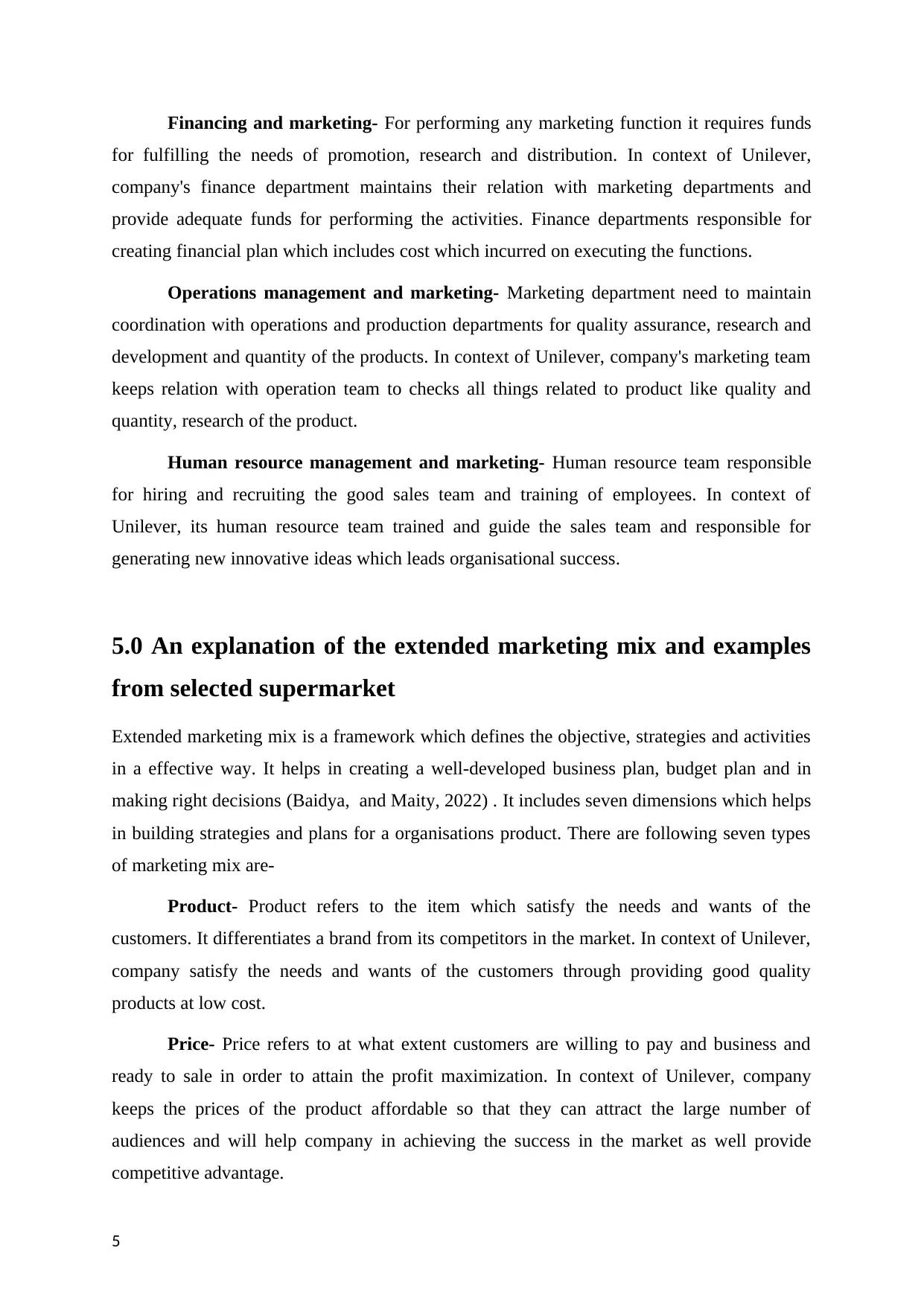
Financing and marketing- For performing any marketing function it requires funds
for fulfilling the needs of promotion, research and distribution. In context of Unilever,
company's finance department maintains their relation with marketing departments and
provide adequate funds for performing the activities. Finance departments responsible for
creating financial plan which includes cost which incurred on executing the functions.
Operations management and marketing- Marketing department need to maintain
coordination with operations and production departments for quality assurance, research and
development and quantity of the products. In context of Unilever, company's marketing team
keeps relation with operation team to checks all things related to product like quality and
quantity, research of the product.
Human resource management and marketing- Human resource team responsible
for hiring and recruiting the good sales team and training of employees. In context of
Unilever, its human resource team trained and guide the sales team and responsible for
generating new innovative ideas which leads organisational success.
5.0 An explanation of the extended marketing mix and examples
from selected supermarket
Extended marketing mix is a framework which defines the objective, strategies and activities
in a effective way. It helps in creating a well-developed business plan, budget plan and in
making right decisions (Baidya, and Maity, 2022) . It includes seven dimensions which helps
in building strategies and plans for a organisations product. There are following seven types
of marketing mix are-
Product- Product refers to the item which satisfy the needs and wants of the
customers. It differentiates a brand from its competitors in the market. In context of Unilever,
company satisfy the needs and wants of the customers through providing good quality
products at low cost.
Price- Price refers to at what extent customers are willing to pay and business and
ready to sale in order to attain the profit maximization. In context of Unilever, company
keeps the prices of the product affordable so that they can attract the large number of
audiences and will help company in achieving the success in the market as well provide
competitive advantage.
5
for fulfilling the needs of promotion, research and distribution. In context of Unilever,
company's finance department maintains their relation with marketing departments and
provide adequate funds for performing the activities. Finance departments responsible for
creating financial plan which includes cost which incurred on executing the functions.
Operations management and marketing- Marketing department need to maintain
coordination with operations and production departments for quality assurance, research and
development and quantity of the products. In context of Unilever, company's marketing team
keeps relation with operation team to checks all things related to product like quality and
quantity, research of the product.
Human resource management and marketing- Human resource team responsible
for hiring and recruiting the good sales team and training of employees. In context of
Unilever, its human resource team trained and guide the sales team and responsible for
generating new innovative ideas which leads organisational success.
5.0 An explanation of the extended marketing mix and examples
from selected supermarket
Extended marketing mix is a framework which defines the objective, strategies and activities
in a effective way. It helps in creating a well-developed business plan, budget plan and in
making right decisions (Baidya, and Maity, 2022) . It includes seven dimensions which helps
in building strategies and plans for a organisations product. There are following seven types
of marketing mix are-
Product- Product refers to the item which satisfy the needs and wants of the
customers. It differentiates a brand from its competitors in the market. In context of Unilever,
company satisfy the needs and wants of the customers through providing good quality
products at low cost.
Price- Price refers to at what extent customers are willing to pay and business and
ready to sale in order to attain the profit maximization. In context of Unilever, company
keeps the prices of the product affordable so that they can attract the large number of
audiences and will help company in achieving the success in the market as well provide
competitive advantage.
5
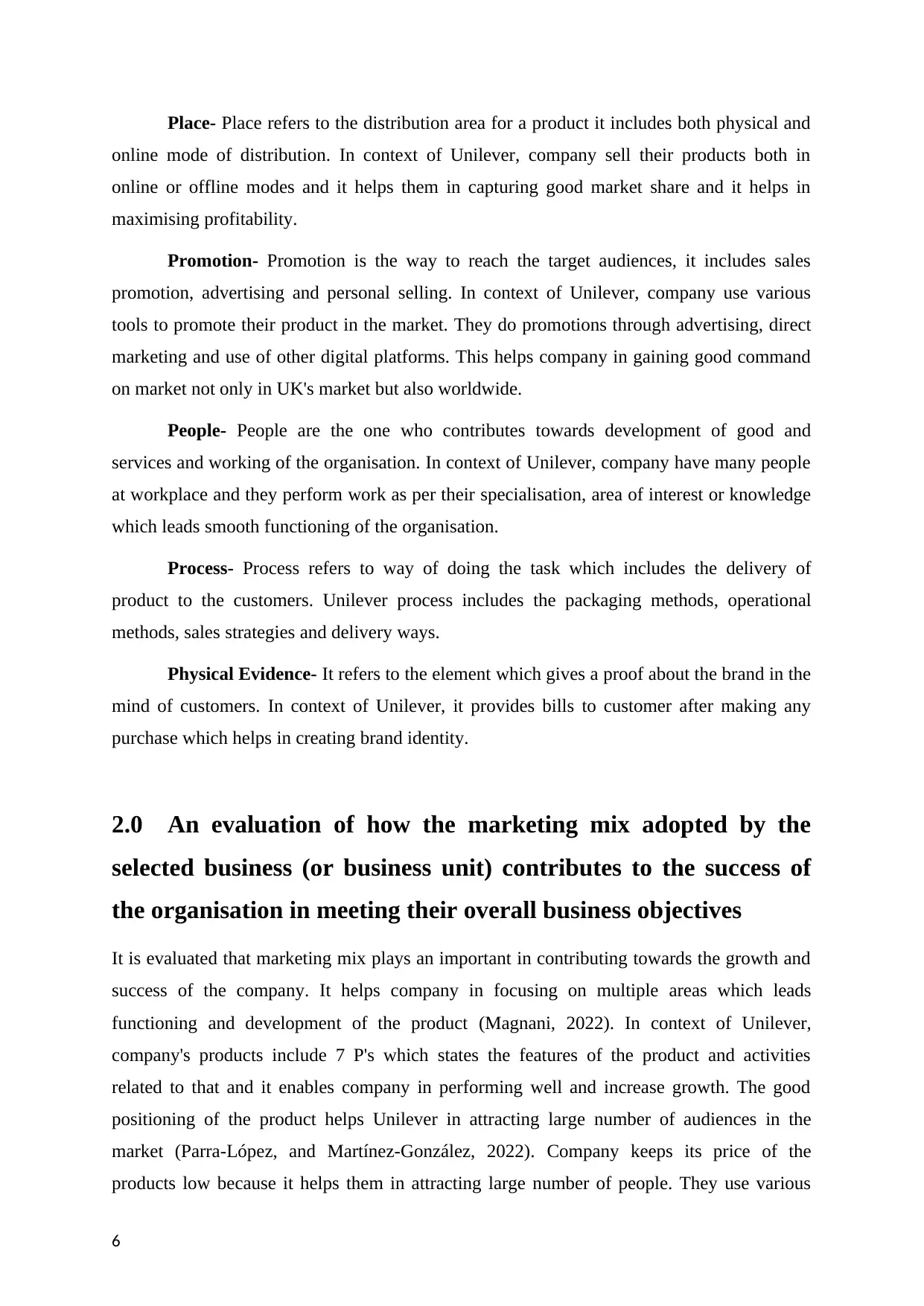
Place- Place refers to the distribution area for a product it includes both physical and
online mode of distribution. In context of Unilever, company sell their products both in
online or offline modes and it helps them in capturing good market share and it helps in
maximising profitability.
Promotion- Promotion is the way to reach the target audiences, it includes sales
promotion, advertising and personal selling. In context of Unilever, company use various
tools to promote their product in the market. They do promotions through advertising, direct
marketing and use of other digital platforms. This helps company in gaining good command
on market not only in UK's market but also worldwide.
People- People are the one who contributes towards development of good and
services and working of the organisation. In context of Unilever, company have many people
at workplace and they perform work as per their specialisation, area of interest or knowledge
which leads smooth functioning of the organisation.
Process- Process refers to way of doing the task which includes the delivery of
product to the customers. Unilever process includes the packaging methods, operational
methods, sales strategies and delivery ways.
Physical Evidence- It refers to the element which gives a proof about the brand in the
mind of customers. In context of Unilever, it provides bills to customer after making any
purchase which helps in creating brand identity.
2.0 An evaluation of how the marketing mix adopted by the
selected business (or business unit) contributes to the success of
the organisation in meeting their overall business objectives
It is evaluated that marketing mix plays an important in contributing towards the growth and
success of the company. It helps company in focusing on multiple areas which leads
functioning and development of the product (Magnani, 2022). In context of Unilever,
company's products include 7 P's which states the features of the product and activities
related to that and it enables company in performing well and increase growth. The good
positioning of the product helps Unilever in attracting large number of audiences in the
market (Parra-López, and Martínez-González, 2022). Company keeps its price of the
products low because it helps them in attracting large number of people. They use various
6
online mode of distribution. In context of Unilever, company sell their products both in
online or offline modes and it helps them in capturing good market share and it helps in
maximising profitability.
Promotion- Promotion is the way to reach the target audiences, it includes sales
promotion, advertising and personal selling. In context of Unilever, company use various
tools to promote their product in the market. They do promotions through advertising, direct
marketing and use of other digital platforms. This helps company in gaining good command
on market not only in UK's market but also worldwide.
People- People are the one who contributes towards development of good and
services and working of the organisation. In context of Unilever, company have many people
at workplace and they perform work as per their specialisation, area of interest or knowledge
which leads smooth functioning of the organisation.
Process- Process refers to way of doing the task which includes the delivery of
product to the customers. Unilever process includes the packaging methods, operational
methods, sales strategies and delivery ways.
Physical Evidence- It refers to the element which gives a proof about the brand in the
mind of customers. In context of Unilever, it provides bills to customer after making any
purchase which helps in creating brand identity.
2.0 An evaluation of how the marketing mix adopted by the
selected business (or business unit) contributes to the success of
the organisation in meeting their overall business objectives
It is evaluated that marketing mix plays an important in contributing towards the growth and
success of the company. It helps company in focusing on multiple areas which leads
functioning and development of the product (Magnani, 2022). In context of Unilever,
company's products include 7 P's which states the features of the product and activities
related to that and it enables company in performing well and increase growth. The good
positioning of the product helps Unilever in attracting large number of audiences in the
market (Parra-López, and Martínez-González, 2022). Company keeps its price of the
products low because it helps them in attracting large number of people. They use various
6
⊘ This is a preview!⊘
Do you want full access?
Subscribe today to unlock all pages.

Trusted by 1+ million students worldwide
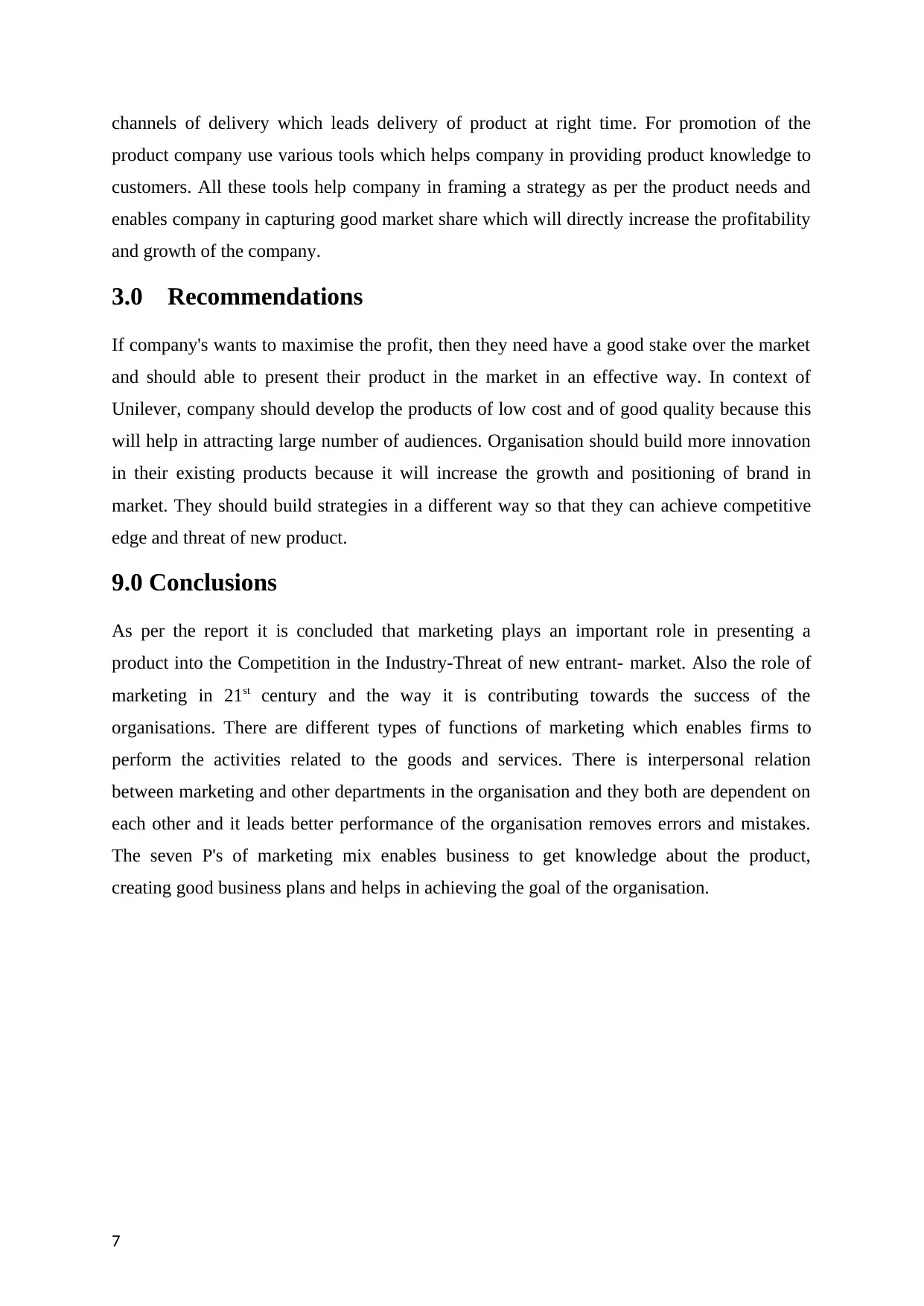
channels of delivery which leads delivery of product at right time. For promotion of the
product company use various tools which helps company in providing product knowledge to
customers. All these tools help company in framing a strategy as per the product needs and
enables company in capturing good market share which will directly increase the profitability
and growth of the company.
3.0 Recommendations
If company's wants to maximise the profit, then they need have a good stake over the market
and should able to present their product in the market in an effective way. In context of
Unilever, company should develop the products of low cost and of good quality because this
will help in attracting large number of audiences. Organisation should build more innovation
in their existing products because it will increase the growth and positioning of brand in
market. They should build strategies in a different way so that they can achieve competitive
edge and threat of new product.
9.0 Conclusions
As per the report it is concluded that marketing plays an important role in presenting a
product into the Competition in the Industry-Threat of new entrant- market. Also the role of
marketing in 21st century and the way it is contributing towards the success of the
organisations. There are different types of functions of marketing which enables firms to
perform the activities related to the goods and services. There is interpersonal relation
between marketing and other departments in the organisation and they both are dependent on
each other and it leads better performance of the organisation removes errors and mistakes.
The seven P's of marketing mix enables business to get knowledge about the product,
creating good business plans and helps in achieving the goal of the organisation.
7
product company use various tools which helps company in providing product knowledge to
customers. All these tools help company in framing a strategy as per the product needs and
enables company in capturing good market share which will directly increase the profitability
and growth of the company.
3.0 Recommendations
If company's wants to maximise the profit, then they need have a good stake over the market
and should able to present their product in the market in an effective way. In context of
Unilever, company should develop the products of low cost and of good quality because this
will help in attracting large number of audiences. Organisation should build more innovation
in their existing products because it will increase the growth and positioning of brand in
market. They should build strategies in a different way so that they can achieve competitive
edge and threat of new product.
9.0 Conclusions
As per the report it is concluded that marketing plays an important role in presenting a
product into the Competition in the Industry-Threat of new entrant- market. Also the role of
marketing in 21st century and the way it is contributing towards the success of the
organisations. There are different types of functions of marketing which enables firms to
perform the activities related to the goods and services. There is interpersonal relation
between marketing and other departments in the organisation and they both are dependent on
each other and it leads better performance of the organisation removes errors and mistakes.
The seven P's of marketing mix enables business to get knowledge about the product,
creating good business plans and helps in achieving the goal of the organisation.
7
Paraphrase This Document
Need a fresh take? Get an instant paraphrase of this document with our AI Paraphraser
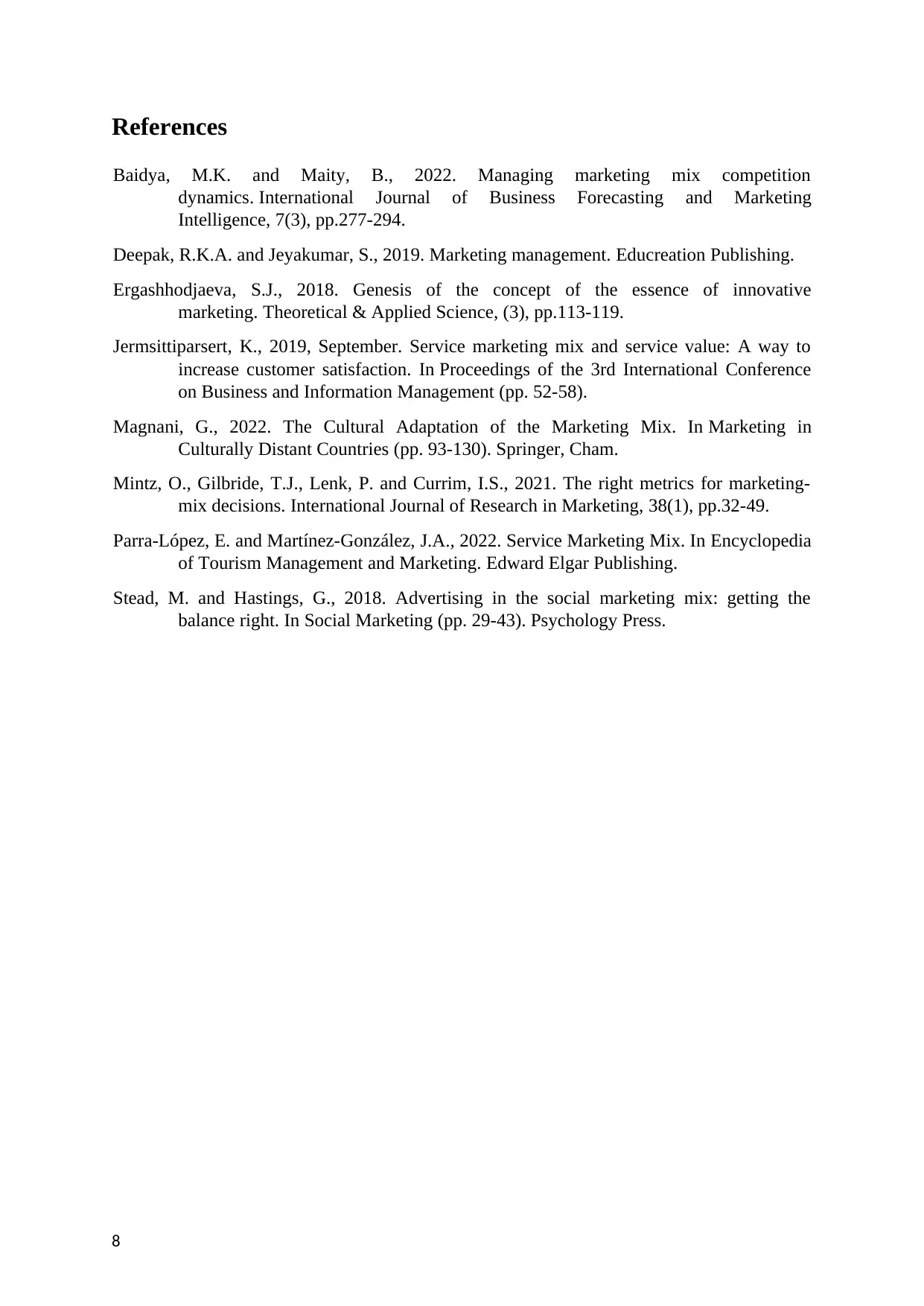
References
Baidya, M.K. and Maity, B., 2022. Managing marketing mix competition
dynamics. International Journal of Business Forecasting and Marketing
Intelligence, 7(3), pp.277-294.
Deepak, R.K.A. and Jeyakumar, S., 2019. Marketing management. Educreation Publishing.
Ergashhodjaeva, S.J., 2018. Genesis of the concept of the essence of innovative
marketing. Theoretical & Applied Science, (3), pp.113-119.
Jermsittiparsert, K., 2019, September. Service marketing mix and service value: A way to
increase customer satisfaction. In Proceedings of the 3rd International Conference
on Business and Information Management (pp. 52-58).
Magnani, G., 2022. The Cultural Adaptation of the Marketing Mix. In Marketing in
Culturally Distant Countries (pp. 93-130). Springer, Cham.
Mintz, O., Gilbride, T.J., Lenk, P. and Currim, I.S., 2021. The right metrics for marketing-
mix decisions. International Journal of Research in Marketing, 38(1), pp.32-49.
Parra-López, E. and Martínez-González, J.A., 2022. Service Marketing Mix. In Encyclopedia
of Tourism Management and Marketing. Edward Elgar Publishing.
Stead, M. and Hastings, G., 2018. Advertising in the social marketing mix: getting the
balance right. In Social Marketing (pp. 29-43). Psychology Press.
8
Baidya, M.K. and Maity, B., 2022. Managing marketing mix competition
dynamics. International Journal of Business Forecasting and Marketing
Intelligence, 7(3), pp.277-294.
Deepak, R.K.A. and Jeyakumar, S., 2019. Marketing management. Educreation Publishing.
Ergashhodjaeva, S.J., 2018. Genesis of the concept of the essence of innovative
marketing. Theoretical & Applied Science, (3), pp.113-119.
Jermsittiparsert, K., 2019, September. Service marketing mix and service value: A way to
increase customer satisfaction. In Proceedings of the 3rd International Conference
on Business and Information Management (pp. 52-58).
Magnani, G., 2022. The Cultural Adaptation of the Marketing Mix. In Marketing in
Culturally Distant Countries (pp. 93-130). Springer, Cham.
Mintz, O., Gilbride, T.J., Lenk, P. and Currim, I.S., 2021. The right metrics for marketing-
mix decisions. International Journal of Research in Marketing, 38(1), pp.32-49.
Parra-López, E. and Martínez-González, J.A., 2022. Service Marketing Mix. In Encyclopedia
of Tourism Management and Marketing. Edward Elgar Publishing.
Stead, M. and Hastings, G., 2018. Advertising in the social marketing mix: getting the
balance right. In Social Marketing (pp. 29-43). Psychology Press.
8
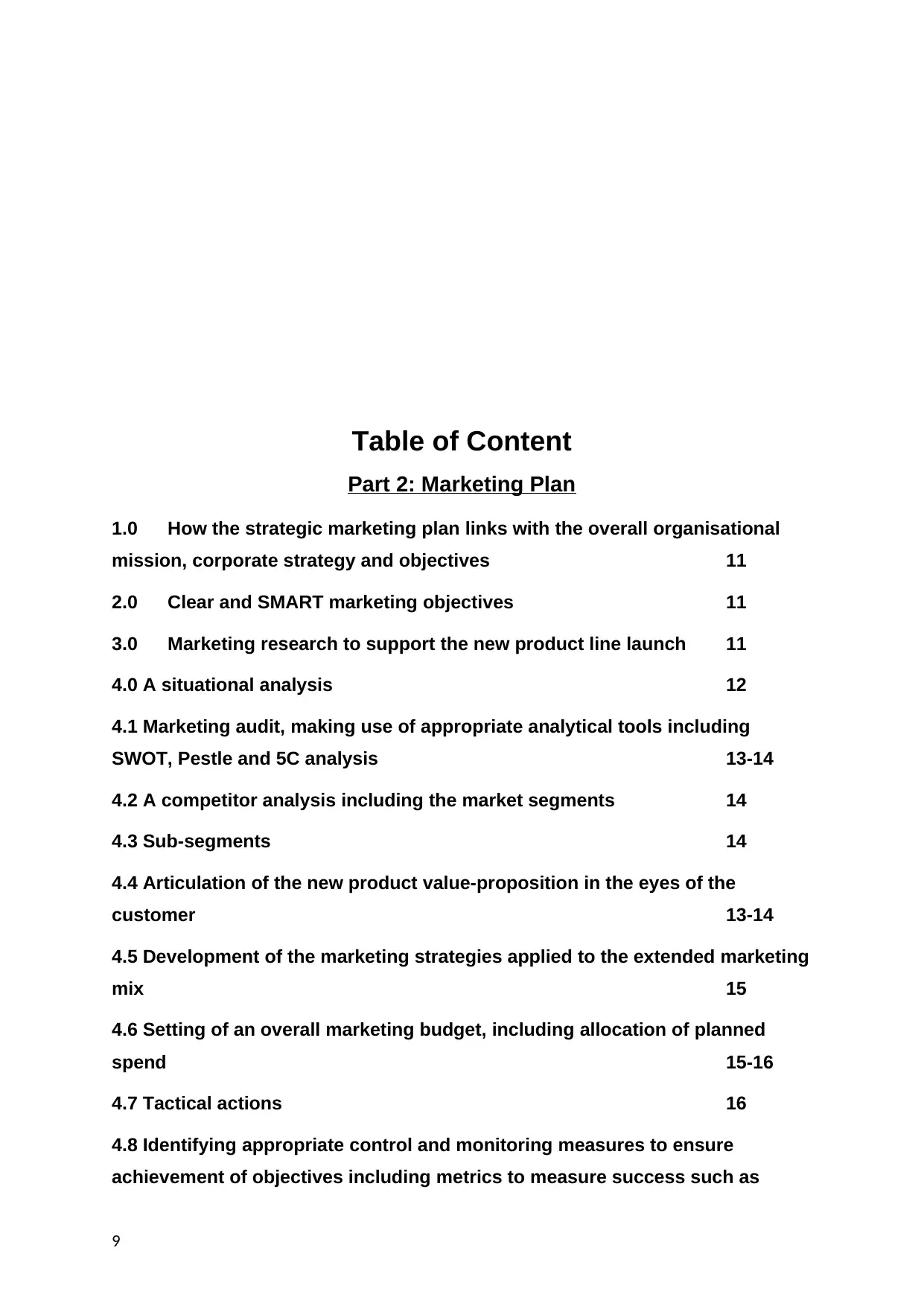
Table of Content
Part 2: Marketing Plan
1.0 How the strategic marketing plan links with the overall organisational
mission, corporate strategy and objectives 11
2.0 Clear and SMART marketing objectives 11
3.0 Marketing research to support the new product line launch 11
4.0 A situational analysis 12
4.1 Marketing audit, making use of appropriate analytical tools including
SWOT, Pestle and 5C analysis 13-14
4.2 A competitor analysis including the market segments 14
4.3 Sub-segments 14
4.4 Articulation of the new product value-proposition in the eyes of the
customer 13-14
4.5 Development of the marketing strategies applied to the extended marketing
mix 15
4.6 Setting of an overall marketing budget, including allocation of planned
spend 15-16
4.7 Tactical actions 16
4.8 Identifying appropriate control and monitoring measures to ensure
achievement of objectives including metrics to measure success such as
9
Part 2: Marketing Plan
1.0 How the strategic marketing plan links with the overall organisational
mission, corporate strategy and objectives 11
2.0 Clear and SMART marketing objectives 11
3.0 Marketing research to support the new product line launch 11
4.0 A situational analysis 12
4.1 Marketing audit, making use of appropriate analytical tools including
SWOT, Pestle and 5C analysis 13-14
4.2 A competitor analysis including the market segments 14
4.3 Sub-segments 14
4.4 Articulation of the new product value-proposition in the eyes of the
customer 13-14
4.5 Development of the marketing strategies applied to the extended marketing
mix 15
4.6 Setting of an overall marketing budget, including allocation of planned
spend 15-16
4.7 Tactical actions 16
4.8 Identifying appropriate control and monitoring measures to ensure
achievement of objectives including metrics to measure success such as
9
⊘ This is a preview!⊘
Do you want full access?
Subscribe today to unlock all pages.

Trusted by 1+ million students worldwide
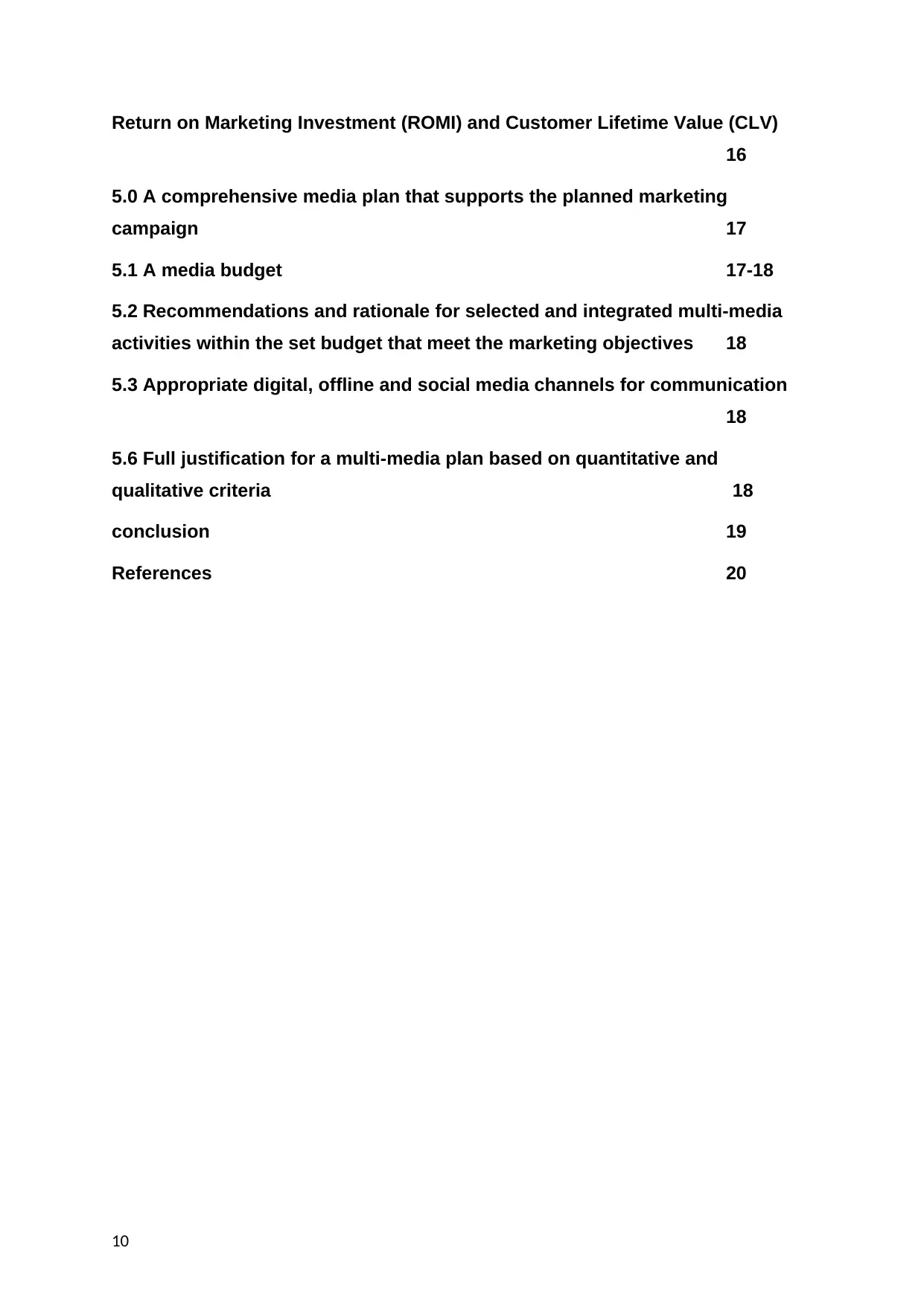
Return on Marketing Investment (ROMI) and Customer Lifetime Value (CLV)
16
5.0 A comprehensive media plan that supports the planned marketing
campaign 17
5.1 A media budget 17-18
5.2 Recommendations and rationale for selected and integrated multi-media
activities within the set budget that meet the marketing objectives 18
5.3 Appropriate digital, offline and social media channels for communication
18
5.6 Full justification for a multi-media plan based on quantitative and
qualitative criteria 18
conclusion 19
References 20
10
16
5.0 A comprehensive media plan that supports the planned marketing
campaign 17
5.1 A media budget 17-18
5.2 Recommendations and rationale for selected and integrated multi-media
activities within the set budget that meet the marketing objectives 18
5.3 Appropriate digital, offline and social media channels for communication
18
5.6 Full justification for a multi-media plan based on quantitative and
qualitative criteria 18
conclusion 19
References 20
10
Paraphrase This Document
Need a fresh take? Get an instant paraphrase of this document with our AI Paraphraser
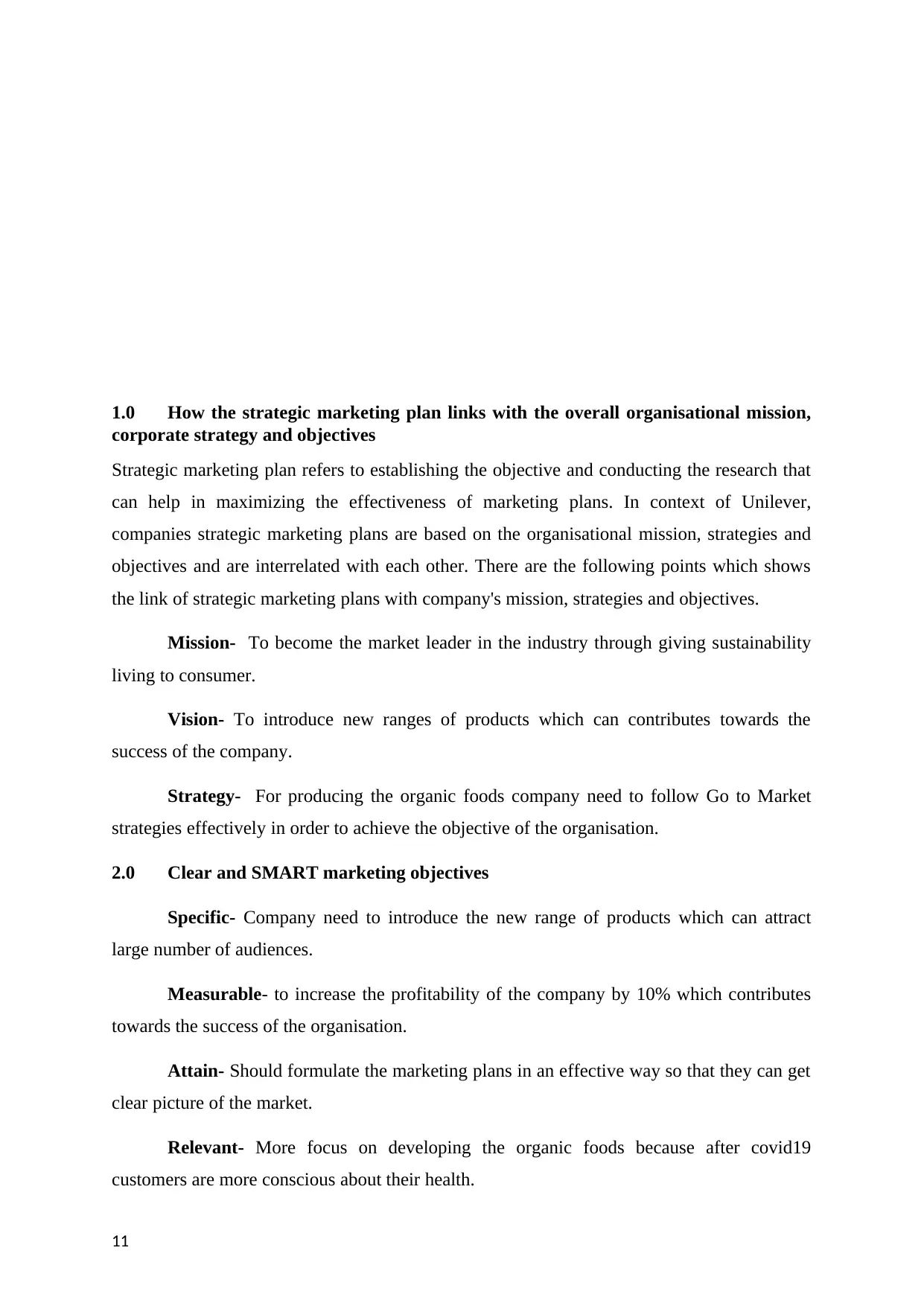
1.0 How the strategic marketing plan links with the overall organisational mission,
corporate strategy and objectives
Strategic marketing plan refers to establishing the objective and conducting the research that
can help in maximizing the effectiveness of marketing plans. In context of Unilever,
companies strategic marketing plans are based on the organisational mission, strategies and
objectives and are interrelated with each other. There are the following points which shows
the link of strategic marketing plans with company's mission, strategies and objectives.
Mission- To become the market leader in the industry through giving sustainability
living to consumer.
Vision- To introduce new ranges of products which can contributes towards the
success of the company.
Strategy- For producing the organic foods company need to follow Go to Market
strategies effectively in order to achieve the objective of the organisation.
2.0 Clear and SMART marketing objectives
Specific- Company need to introduce the new range of products which can attract
large number of audiences.
Measurable- to increase the profitability of the company by 10% which contributes
towards the success of the organisation.
Attain- Should formulate the marketing plans in an effective way so that they can get
clear picture of the market.
Relevant- More focus on developing the organic foods because after covid19
customers are more conscious about their health.
11
corporate strategy and objectives
Strategic marketing plan refers to establishing the objective and conducting the research that
can help in maximizing the effectiveness of marketing plans. In context of Unilever,
companies strategic marketing plans are based on the organisational mission, strategies and
objectives and are interrelated with each other. There are the following points which shows
the link of strategic marketing plans with company's mission, strategies and objectives.
Mission- To become the market leader in the industry through giving sustainability
living to consumer.
Vision- To introduce new ranges of products which can contributes towards the
success of the company.
Strategy- For producing the organic foods company need to follow Go to Market
strategies effectively in order to achieve the objective of the organisation.
2.0 Clear and SMART marketing objectives
Specific- Company need to introduce the new range of products which can attract
large number of audiences.
Measurable- to increase the profitability of the company by 10% which contributes
towards the success of the organisation.
Attain- Should formulate the marketing plans in an effective way so that they can get
clear picture of the market.
Relevant- More focus on developing the organic foods because after covid19
customers are more conscious about their health.
11
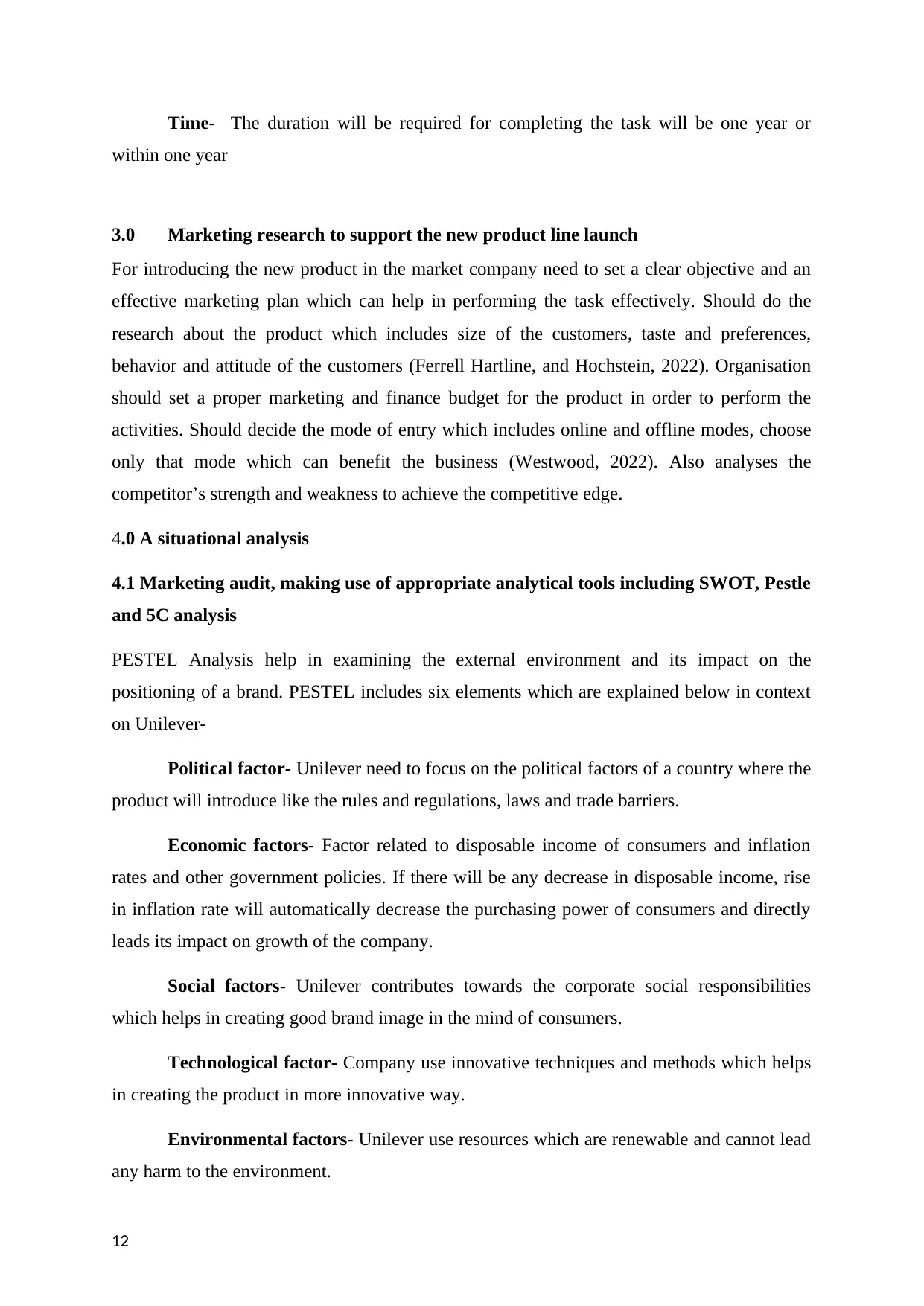
Time- The duration will be required for completing the task will be one year or
within one year
3.0 Marketing research to support the new product line launch
For introducing the new product in the market company need to set a clear objective and an
effective marketing plan which can help in performing the task effectively. Should do the
research about the product which includes size of the customers, taste and preferences,
behavior and attitude of the customers (Ferrell Hartline, and Hochstein, 2022). Organisation
should set a proper marketing and finance budget for the product in order to perform the
activities. Should decide the mode of entry which includes online and offline modes, choose
only that mode which can benefit the business (Westwood, 2022). Also analyses the
competitor’s strength and weakness to achieve the competitive edge.
4.0 A situational analysis
4.1 Marketing audit, making use of appropriate analytical tools including SWOT, Pestle
and 5C analysis
PESTEL Analysis help in examining the external environment and its impact on the
positioning of a brand. PESTEL includes six elements which are explained below in context
on Unilever-
Political factor- Unilever need to focus on the political factors of a country where the
product will introduce like the rules and regulations, laws and trade barriers.
Economic factors- Factor related to disposable income of consumers and inflation
rates and other government policies. If there will be any decrease in disposable income, rise
in inflation rate will automatically decrease the purchasing power of consumers and directly
leads its impact on growth of the company.
Social factors- Unilever contributes towards the corporate social responsibilities
which helps in creating good brand image in the mind of consumers.
Technological factor- Company use innovative techniques and methods which helps
in creating the product in more innovative way.
Environmental factors- Unilever use resources which are renewable and cannot lead
any harm to the environment.
12
within one year
3.0 Marketing research to support the new product line launch
For introducing the new product in the market company need to set a clear objective and an
effective marketing plan which can help in performing the task effectively. Should do the
research about the product which includes size of the customers, taste and preferences,
behavior and attitude of the customers (Ferrell Hartline, and Hochstein, 2022). Organisation
should set a proper marketing and finance budget for the product in order to perform the
activities. Should decide the mode of entry which includes online and offline modes, choose
only that mode which can benefit the business (Westwood, 2022). Also analyses the
competitor’s strength and weakness to achieve the competitive edge.
4.0 A situational analysis
4.1 Marketing audit, making use of appropriate analytical tools including SWOT, Pestle
and 5C analysis
PESTEL Analysis help in examining the external environment and its impact on the
positioning of a brand. PESTEL includes six elements which are explained below in context
on Unilever-
Political factor- Unilever need to focus on the political factors of a country where the
product will introduce like the rules and regulations, laws and trade barriers.
Economic factors- Factor related to disposable income of consumers and inflation
rates and other government policies. If there will be any decrease in disposable income, rise
in inflation rate will automatically decrease the purchasing power of consumers and directly
leads its impact on growth of the company.
Social factors- Unilever contributes towards the corporate social responsibilities
which helps in creating good brand image in the mind of consumers.
Technological factor- Company use innovative techniques and methods which helps
in creating the product in more innovative way.
Environmental factors- Unilever use resources which are renewable and cannot lead
any harm to the environment.
12
⊘ This is a preview!⊘
Do you want full access?
Subscribe today to unlock all pages.

Trusted by 1+ million students worldwide
1 out of 20
Related Documents
Your All-in-One AI-Powered Toolkit for Academic Success.
+13062052269
info@desklib.com
Available 24*7 on WhatsApp / Email
![[object Object]](/_next/static/media/star-bottom.7253800d.svg)
Unlock your academic potential
Copyright © 2020–2025 A2Z Services. All Rights Reserved. Developed and managed by ZUCOL.

